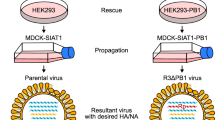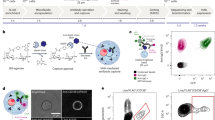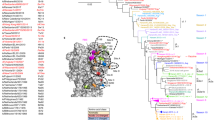Abstract
Pre-existing neutralizing antibody provides the first line of defence against pathogens in general. For influenza virus, annual vaccinations are given to maintain protective levels of antibody against the currently circulating strains. Here we report that after booster vaccination there was a rapid and robust influenza-specific IgG+ antibody-secreting plasma cell (ASC) response that peaked at approximately day 7 and accounted for up to 6% of peripheral blood B cells. These ASCs could be distinguished from influenza-specific IgG+ memory B cells that peaked 14–21 days after vaccination and averaged 1% of all B cells. Importantly, as much as 80% of ASCs purified at the peak of the response were influenza specific. This ASC response was characterized by a highly restricted B-cell receptor (BCR) repertoire that in some donors was dominated by only a few B-cell clones. This pauci-clonal response, however, showed extensive intraclonal diversification from accumulated somatic mutations. We used the immunoglobulin variable regions isolated from sorted single ASCs to produce over 50 human monoclonal antibodies (mAbs) that bound to the three influenza vaccine strains with high affinity. This strategy demonstrates that we can generate multiple high-affinity mAbs from humans within a month after vaccination. The panel of influenza-virus-specific human mAbs allowed us to address the issue of original antigenic sin (OAS): the phenomenon where the induced antibody shows higher affinity to a previously encountered influenza virus strain compared with the virus strain present in the vaccine1. However, we found that most of the influenza-virus-specific mAbs showed the highest affinity for the current vaccine strain. Thus, OAS does not seem to be a common occurrence in normal, healthy adults receiving influenza vaccination.
This is a preview of subscription content, access via your institution
Access options
Subscribe to this journal
Receive 51 print issues and online access
$199.00 per year
only $3.90 per issue
Buy this article
- Purchase on SpringerLink
- Instant access to full article PDF
Prices may be subject to local taxes which are calculated during checkout




Similar content being viewed by others
References
Francis, T. On the doctrine of original antigenic sin. Proc. Am. Phil. Soc. 104, 572–578 (1960)
Ahmed, R., Oldstone, M. B. & Palese, P. Protective immunity and susceptibility to infectious diseases: lessons from the 1918 influenza pandemic. Nature Immunol. 8, 1188–1193 (2007)
Subbarao, K. & Joseph, T. Scientific barriers to developing vaccines against avian influenza viruses. Nature Rev. Immunol. 7, 267–278 (2007)
Gerhard, W. et al. Role of the B-cell response in recovery of mice from primary influenza virus infection. Immunol. Rev. 159, 95–103 (1997)
Luke, T. C., Kilbane, E. M., Jackson, J. L. & Hoffman, S. L. Meta-analysis: convalescent blood products for Spanish influenza pneumonia: a future H5N1 treatment? Ann. Intern. Med. 145, 599–609 (2006)
Puck, J. M., Glezen, W. P., Frank, A. L. & Six, H. R. Protection of infants from infection with influenza A virus by transplacentally acquired antibody. J. Infect. Dis. 142, 844–849 (1980)
Simmons, C. P. et al. Prophylactic and therapeutic efficacy of human monoclonal antibodies against H5N1 influenza. PLoS Med. 4, e178 (2007)
Bernasconi, N. L., Traggiai, E. & Lanzavecchia, A. Maintenance of serological memory by polyclonal activation of human memory B cells. Science 298, 2199–2202 (2002)
Brokstad, K. A. et al. Parenteral influenza vaccination induces a rapid systemic and local immune response. J. Infect. Dis. 171, 198–203 (1995)
Brokstad, K. A. et al. Parenteral vaccination against influenza does not induce a local antigen-specific immune response in the nasal mucosa. J. Infect. Dis. 185, 878–884 (2002)
Sasaki, S. et al. Comparison of the influenza virus-specific effector and memory B-cell responses to immunization of children and adults with live attenuated or inactivated influenza virus vaccines. J. Virol. 81, 215–228 (2007)
Poulsen, T. R. et al. Kinetic, affinity, and diversity limits of human polyclonal antibody responses against tetanus toxoid. J. Immunol. 179, 3841–3850 (2007)
Odendahl, M. et al. Generation of migratory antigen-specific plasma blasts and mobilization of resident plasma cells in a secondary immune response. Blood 105, 1614–1621 (2005)
Crotty, S., Aubert, R. D., Glidewell, J. & Ahmed, R. Tracking human antigen-specific memory B cells: a sensitive and generalized ELISPOT system. J. Immunol. Methods 286, 111–122 (2004)
Koelsch, K. et al. Mature B cells class switched to IgD are autoreactive in healthy individuals. J. Clin. Invest. 117, 1558–1565 (2007)
Zheng, N. Y., Wilson, K., Jared, M. & Wilson, P. C. Intricate targeting of immunoglobulin somatic hypermutation maximizes the efficiency of affinity maturation. J. Exp. Med. 201, 1467–1478 (2005)
Zheng, N. Y. et al. Human immunoglobulin selection associated with class switch and possible tolerogenic origins for C delta class-switched B cells. J. Clin. Invest. 113, 1188–1201 (2004)
Clarke, S. H. et al. Inter- and intraclonal diversity in the antibody response to influenza hemagglutinin. J. Exp. Med. 161, 687–704 (1985)
Cook, W. D. & Scharff, M. D. Antigen-binding mutants of mouse myeloma cells. Proc. Natl Acad. Sci. USA 74, 5687–5691 (1977)
Meijer, P. J. et al. Isolation of human antibody repertoires with preservation of the natural heavy and light chain pairing. J. Mol. Biol. 358, 764–772 (2006)
Llewelyn, M. B., Hawkins, R. E. & Russell, S. J. Discovery of antibodies. Br. Med. J. 305, 1269–1272 (1992)
Crotty, S. et al. SAP is required for generating long-term humoral immunity. Nature 421, 282–287 (2003)
Webster, R., Cox, N. & Stohr, K. World Health Organization Manual on Animal Influenza Diagnosis and Surveillance (WHO, Geneva, 2002)
Wardemann, H. et al. Predominant autoantibody production by early human B cell precursors. Science 301, 1374–1377 (2003)
Crotty, S. et al. Cutting edge: long-term B cell memory in humans after smallpox vaccination. J. Immunol. 171, 4969–4973 (2003)
Hartmann, G. et al. Delineation of a CpG phosphorothioate oligodeoxynucleotide for activating primate immune responses in vitro and in vivo. J. Immunol. 164, 1617–1624 (2000)
Wilson, P. C. et al. Receptor revision of immunoglobulin heavy chain variable region genes in normal human B lymphocytes. J. Exp. Med. 191, 1881–1894 (2000)
Stephenson, I. et al. Detection of anti-H5 responses in human sera by HI using horse erythrocytes following MF59-adjuvanted influenza A/Duck/Singapore/97 vaccine. Virus Res. 103, 91–95 (2004)
Acknowledgements
We thank A. Popkowski, H. Wu, L. Abraham and B. Begley for technical assistance, and R. Casellas and J. Knight for reading the manuscript. This work was funded in parts by National Institutes of Health (NIH) grant numbers HHSN266200500026C (P.C.W.), P20 RR018758 (P.C.W.), NIH/National Institute of Allergy and Infectious Diseases (NIAID) U19-AI057266-04 (R.A.), NIH/NIAID HHSN266200700006C Center of Excellence for Influenza Research and Surveillance (R.A.) and NIH/NIAID N01-AI-50025-02 (R.A. and C.L.). J.W. was supported by a postdoctoral fellowship from The Swedish Research Council.
Author information
Authors and Affiliations
Corresponding author
Supplementary information
Supplementary information
The file contains Supplementary Figures 1-4 with Legends, Supplementary Tables 1-2 and Supplementary Methods (PDF 3828 kb)
Rights and permissions
About this article
Cite this article
Wrammert, J., Smith, K., Miller, J. et al. Rapid cloning of high-affinity human monoclonal antibodies against influenza virus. Nature 453, 667–671 (2008). https://doi.org/10.1038/nature06890
Received:
Accepted:
Published:
Issue date:
DOI: https://doi.org/10.1038/nature06890
This article is cited by
-
Assessing antibody and nanobody nativeness for hit selection and humanization with AbNatiV
Nature Machine Intelligence (2024)
-
Vaccination of SARS-CoV-2-infected individuals expands a broad range of clonally diverse affinity-matured B cell lineages
Nature Communications (2023)
-
Infection pre-Ad26.COV2.S-vaccination primes greater class switching and reduced CXCR5 expression by SARS-CoV-2-specific memory B cells
npj Vaccines (2023)
-
Reemergence of pathogenic, autoantibody-producing B cell clones in myasthenia gravis following B cell depletion therapy
Acta Neuropathologica Communications (2022)
-
PD-1 blockade unblocks immune responses to vaccination
Nature Immunology (2022)



